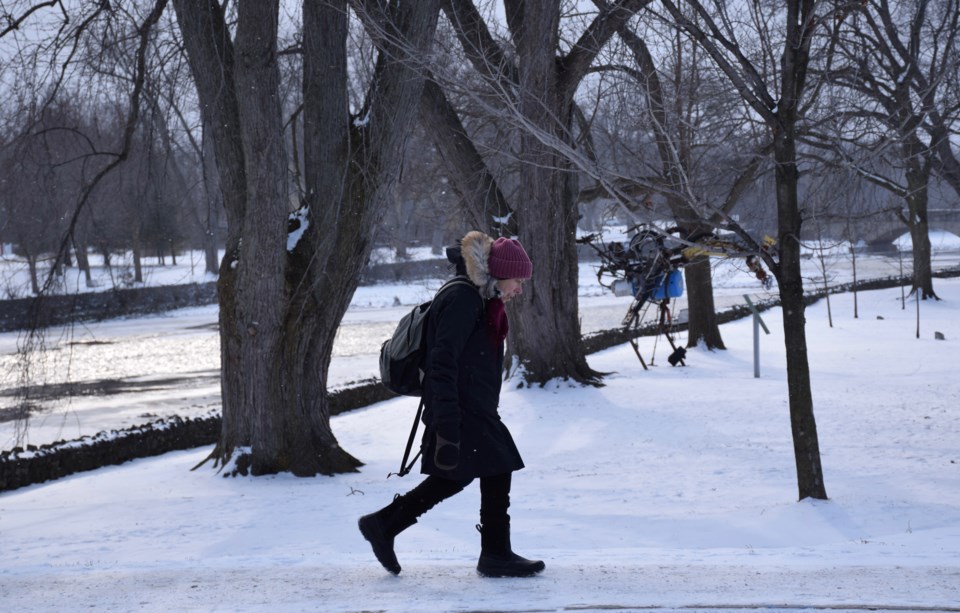Before 2017 came to an end, Sudburians experienced the coldest week of weather since 2014, according to Environment Canada.
Beginning Dec. 26 — Boxing Day — the temperature started to nose dive, dipping to a frostbite-inducing -29.2 C that day.
It was even colder the next day, at -32.7 C on Dec. 27.
It warmed back up to -29.9 C on Dec. 28, before the temperature rose again on Dec. 29 to a balmy -25.8 C and on Dec. 30 at -25.9 C.
The year went out with a frigid bang on Dec. 31 with a temperature of -29.6 C.
In 2018, Jan. 4 was a record-setting day, with the temperature reaching a low of -29.9 C.
Of course, when you factor in windchill, it only made the matters worse, especially for those who are living on the streets in the city.
Northeastern Ontario can expect windchill values between -40 to -48 C once again tonight and Saturday morning.
However, Sudburians can expect to see a reprieve from the cold starting Sunday, when the high is supposed to be -11 C with a chance of snow.
The warming trend will continue on Monday, with the mercury rising to a high of -6 C.
It will be a welcome change, without a doubt, but residents still have to get through the next few days.
As such, the Sudbury and District Health Unit reminds everyone to take appropriate precautions in the cold. Injuries related to the cold can happen at a wide range of temperatures, but occur more quickly when it’s colder.
Hypothermia and frostbite are the most common and preventable injuries.
Suffering frostbite means that skin has actually frozen. In addition to feeling cold, the skin can feel numb and appear white. Body extremities are often the first to be frozen, for example, the nose, cheeks, ears, fingers, and toes.
If frostbite is suspected, immediately treat the area by somehow covering it. Never rub or massage the area because it could damage the skin tissue. If possible, gently place the area in warm water (not hot) until it is warm and no longer numb. Apply a sterile dressing to the area, and place dressings between fingers and toes if they are affected. Seek medical attention to avoid further complications.
Hypothermia is a life-threatening condition. It occurs when the body is exposed to the cold for a long time and loses more heat than it can generate. The individual could be shivering, drowsy, confused, and have slurred speech, loss of coordination, and pale and bluish lips.
When they stop shivering, their condition becomes severe and unconsciousness can soon follow.
Treat hypothermia by moving the person to shelter, replacing wet clothing with dry clothing, and wrapping them in warm blankets. Keep the person lying flat and get immediate medical attention.
To prevent cold related injuries:
- Listen to the weather forecast and plan accordingly.
- Dress in layers, with a wind resistant outer layer. Wear a hat and mittens or insulated gloves. Keep your face warm by wearing a scarf, neck tube or facemask.
- Wear warm and waterproof footwear that fits properly.
- Stay dry. Wet clothing chills the body rapidly. Remove outer layers of clothing or open your coat if you are sweating.
- Stay active, walking or running will help warm you by generating body heat.
- Seek shelter from the wind.
- Monitor individuals who have dementia, a psychiatric diagnosis, or who are under the influence of alcohol or drugs as they are at higher risk for cold related injuries. Speak to your doctor or pharmacist as certain medications can also make you more susceptible.
On very cold days, check-in on neighbours who may be vulnerable to cold due to age, living conditions, health conditions, reduced mobility, or isolation.
People experiencing homelessness spend long periods outside and can suffer increased effects from the cold. This can be due to the following issues as well as other factors:
- inadequate clothing
- malnutrition
- a previous cold-weather injury
- a history of heart disease and/or diabetes
The possibility of severe non-fatal impacts of cold weather, such as amputation or extended hospitalizations, increases for homeless individuals because of these factors.
To help people in these situations, consider donating warm blankets, warm socks, mittens, hats, long underwear, footwear and outerwear to local aid groups, for example, the Salvation Army or the Elgin Street Mission.
Donations to the Off the Street overnight winter shelter can be dropped off between 8:30 a.m. and 4:30 p.m. at the Canadian Mental Health Association, 111 Elm St.
For more information on preventing cold weather injuries, visit sdhu.com or phone the Health Unit at 705-522-9200, ext. 464, toll-free 1-866-522-9200.
